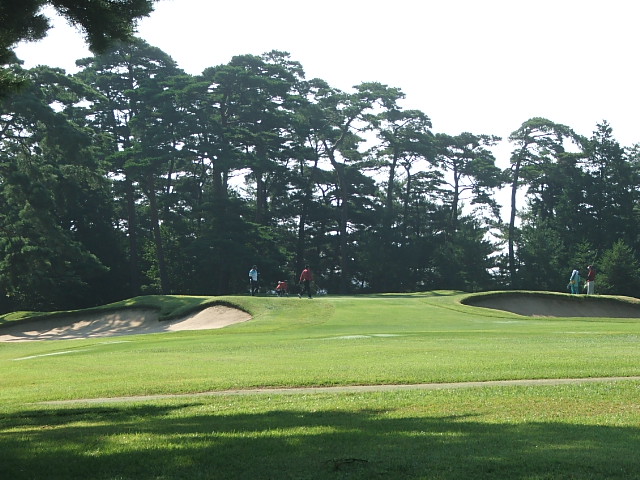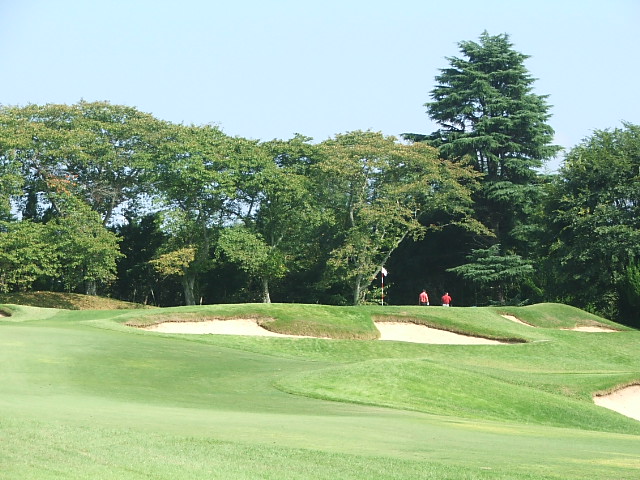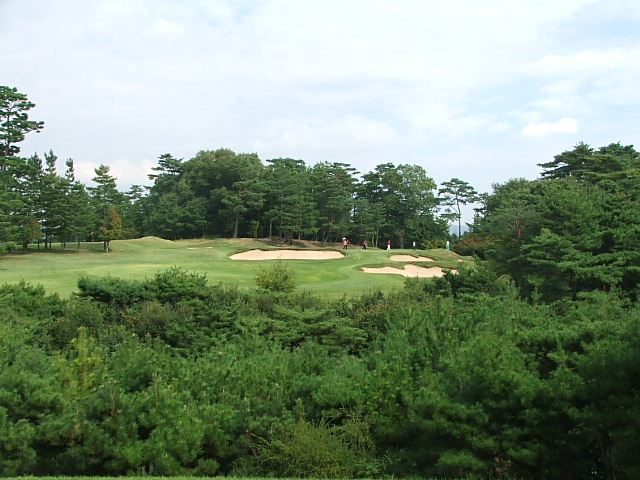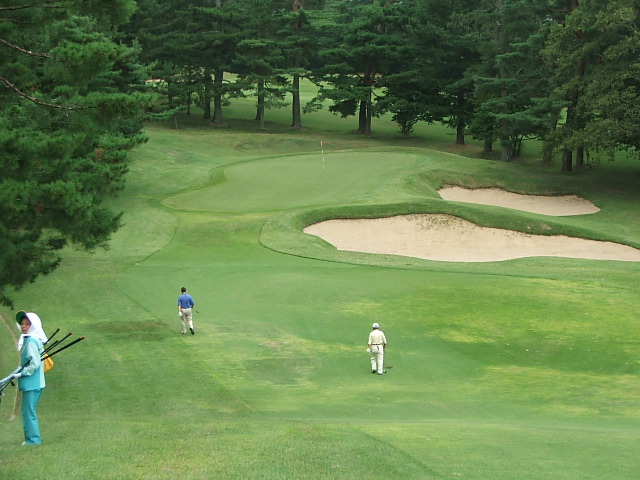
Naruo Golf Club (ranked #75 in the world) is located in the hills between Kobe and Osaka. Naruo is a private golf course and you must play with a member. The course was designed by Scottish professionals Joe Crane and H.C. Crane in 1904 with revisions made by C.H. Alison in 1930. The course was founded by British expatriates and is Japan's hidden gem. Naruo is a narrow, quirky and very difficult golf course. The greens at Naruo are 'korai' grass, which is like a thicker version of Bermuda and is quite slow, running about an eight on the stimp meter.
If you haven't read the post on how structured golf is in Japan,
click here to learn the proper protocol.
If you ever have the opportunity to play Naruo Golf Club I suggest you do some training beforehand. Perhaps run a marathon, enter an Ironman competition or train for the Olympics. You need to be fit to play Naruo. The course is built on terrain that is quite hilly and is one of the most difficult courses I have ever walked. As with all private courses in Japan, there are caddies and you walk the course. How difficult is Naruo to walk? So difficult that they have built in a traction system around all eighteen holes so that the caddies don't have to push the carts up and down the hilly terrain. The mechanized system works with some sort of magnets under the ground and the caddie controls it by remote control. The property at Naruo reminded me of Bel-Air Country Club in Los Angeles because it is a relatively small piece of landlocked hilly property.

The cart tram at Naruo
The course is not only narrow, but also has a lot of uneven lies. I personally rank it as one of the hardest courses in the world along with Bethpage, Oakmont and Carnoustie. Playing Naruo requires you to embrace the Japanese phrase nanakorobi yaoki which translates to 'perseverance is better than defeat'. The Japanese occasionally adapt a close variation of an English word to describe something. I wouldn't at all be surprised if Naruo were a bastardization of the English word 'narrow'.
Almost every hole at Naruo has an out of bounds. The first hole is a good example of what you find a Naruo. Notice the narrowness of the fairway, sloping fairways and an elevated, small green in the distance on the right.

The narrow 1st hole at Naruo, par four 383 yards
The course has tiny greens, most are elevated and as is typical on an Alison designed course, well bunkered. Below are two good examples of the well bunkered greens on the 2nd and 4th holes, both par threes.

Elevated 2nd green - par three 182 yards

Elevated 4th green - par three 207 yards
Naruo has an interesting and varied routing that offers no respite. The 8th hole is a remarkable par four that doglegs more than ninety degrees. It is a 437 yard par four that is in the shape of a semi-circle.

It is a double-dogleg that sweeps around to the left with O.B. on both sides of the hole the entire way. You have to hit your drive both long and to the right if you want any hope of seeing the flag.

The flag is set around a dramatic dog leg to the left and has a very narrow opening, is elevated and well protected with bunkers.

8th from the fairway looking at the green
The hole plays in spectacular isolation and is as beautiful as any inland hole you will ever play. The round green, seen below looking backward, is typical of many Alison greens.

The tilted 8th green looking back at fairway

View from the 9th tee
After you finish the front nine there is a little mechanized golf cart that brings you up a steep incline back to the clubhouse to have lunch. The cart seats four and is so absurdly slow that you could clearly walk up a lot faster, but at this point, most people are hurting, so it is a nice transition to lunch.
The 10th hole is the hardest par four I have ever played. It makes the Road Hole at St. Andrews look like a birdie opportunity. It plays 470 yards and it is best to hit a very long drive here since you want your second shot to be as short as possible. The forced carry is over 'death valley', a 170 to 200 yard carry over a chasm that has a thirty foot drop. If you are unlucky enough to have your ball go down into the valley of death, you can't even remotely see where the flag or hole is located.

10th hole looking back from green across ravine
We played the 10th into a wind and I was so far back that I played my second shot to a nearby fairway on another hole so that I could avoid the chasm. I made a double bogey but at least I came back alive and didn't get lost down in that un-godly thing.
The 15th, a par three, reminded me of the par three 4th hole at Royal County Down with its forced carry over heather. Here, the carry is over Japanese pines and is 175 yards, uphill.

15th, a tough par three
The 15th hole also has a typically Japanese experience. At all Japanese courses there is a structured protocol that must be followed. At Naruo we had the archetypal Japanese golf experience. The arrival and check-in, the pre-round cup of coffee, the lunch with beer and coffee. At Naruo, in addition to the usual routine, the tradition also includes a quick cup of small tea. At the 15th hole, there is a little house where you have a cup of tea before playing the hole.

tea house by the 15th hole
The sixteenth is a 378 yard par four with a blind tee shot. You can see from the picture below the steepness of the terrain at Naruo and the unusual outfits the female caddies wear.

16th approach to the green
After the round we had a shower, communal bath and another round of beers. As we were sitting in the clubhouse butchering the Japanese language the server brought out a bowl of nuts and some other munchies that looked like pretzels. Turns out they are some sort of fish cracker wrapped in seaweed. I popped one into my mouth and wish I could have spit it out, but sucked it up and told our host how delicious it was!
Naruo is a 6,565 yard course but plays longer because of the elevation. On the negative side Naruo has too much O.B. for my game and the greens are arguably too small. The sand was like hard pan and in poor condition when I played. The traction system moving the bags around is amusing and unique but ultimately annoying since your clubs can often be far away from where you are hitting your shot. You can run the poor caddie ragged getting clubs and running back and forth in her head-to-toe polyester suit.
If you are a near scratch or better play, you will play Naruo well. If not, you will still enjoy one of the best golf courses in the world, but be prepared to be beat up both physically and mentally. Naruo is clearly worthy of its place in the world rankings.
Finishing the round at Naruo was a sad experience for me. It was the last course I played on my grand tour of Japan's top courses. I very much enjoyed playing these top shelf courses and enjoyed the politeness and hospitality of our hosts immensely. I don't know that my budget or my wife will ever permit me to return, which is too bad. I will always treasure my golfing memories here.

Check out the club's website, although it is in Japanese, they have nice video images of each hole:
Naruo Golf Club's Website















